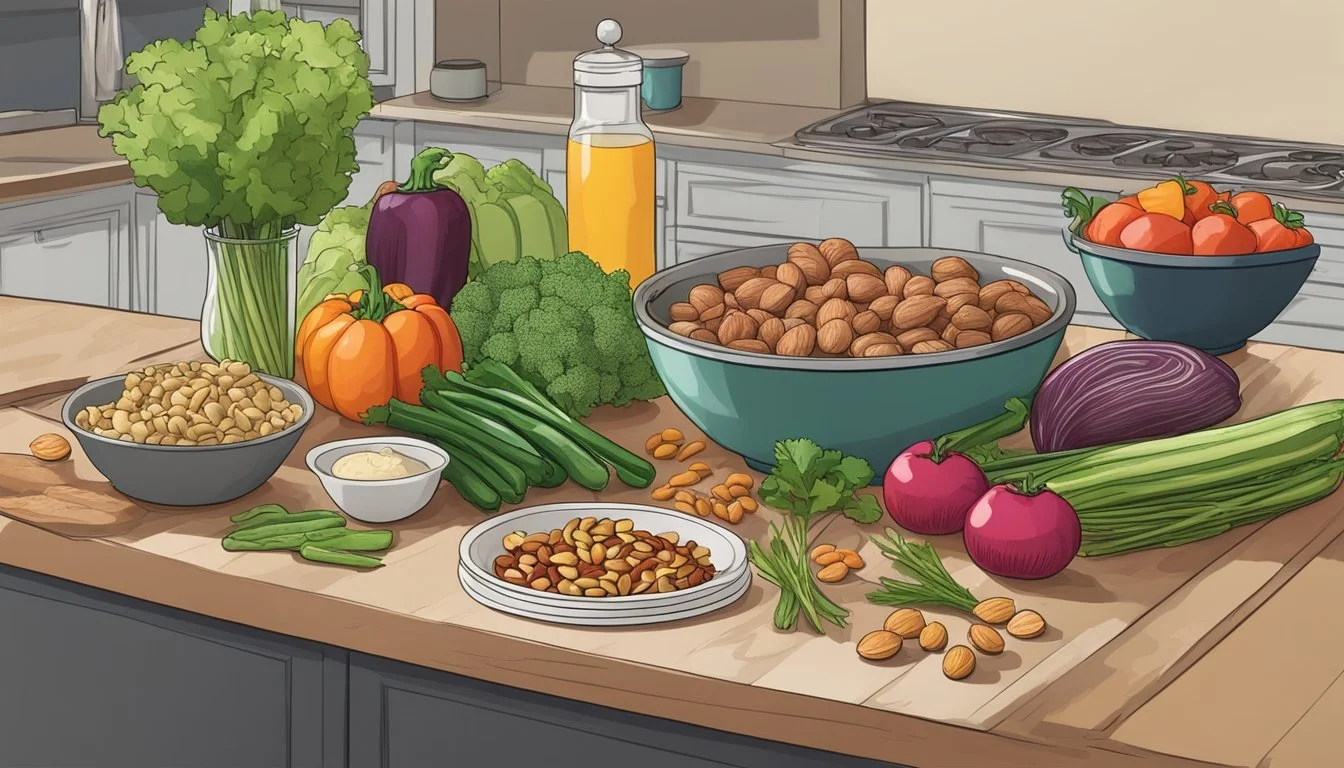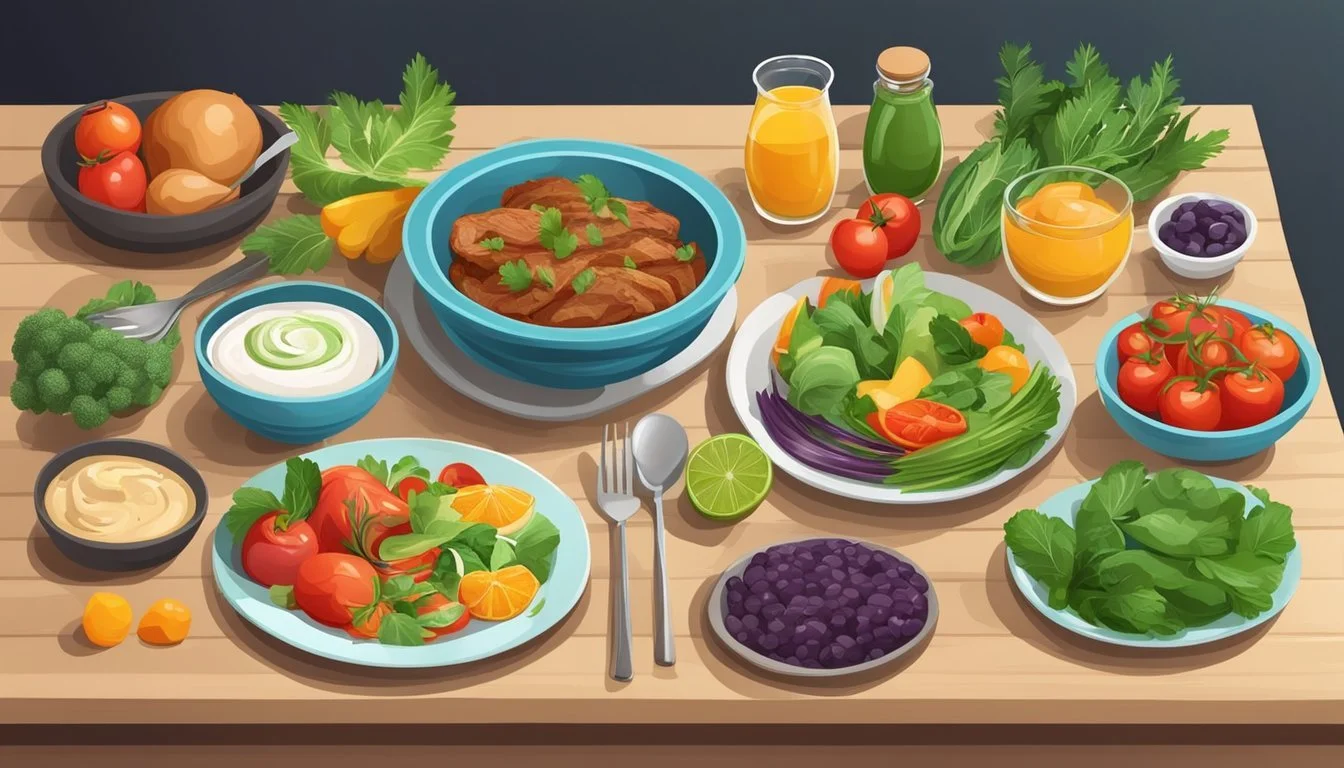Easy Paleo Diet Recipes
Quick and Nutritious Meals for Beginners
The paleo diet, often referred to as the "caveman diet," is centered around the concept of eating whole, unprocessed foods that our Paleolithic ancestors might have consumed. Paleo diet recipes often include a variety of meats, fish, fruits, vegetables, nuts, and seeds. (how long do seeds last?) The diet excludes grains, legumes, refined sugars, and most dairy products. Its proponents claim that by eating like our pre-agricultural ancestors, people can align more closely with their genetics and improve their health, potentially reducing the risk of chronic diseases.
Easy Paleo recipes cater to modern cooks looking for simplicity in meal preparation without sacrificing the principles of the Paleo diet. These Paleo recipes typically feature a limited number of ingredients, straightforward steps, and quick cooking methods. Dishes such as one-pan meals, hearty salads, and no-fuss main courses demonstrate that paleo meals can be both accessible and diverse. Many of these Paleo recipes are designed to fit into busy lifestyles, allowing for nourishing meals that align with Paleo guidelines to be made in 30 minutes or less.
With a focus on quality ingredients and natural flavor combinations, easy paleo recipes are a gateway to discovering how satisfying and varied the diet can be. From the savory breakfast frittatas to ingredient-packed soups and vibrant stir-fries, these meals are crafted to be enjoyed by both novices and seasoned Paleo enthusiasts alike. The adoption of such Paleo recipes can facilitate a smooth transition into the Paleo lifestyle and ensure sustained adherence through convenience and taste.
What is the Paleo Diet?
The Paleo Diet harks back to the eating habits of our Paleolithic ancestors, focusing on whole, unprocessed foods. It is often synonymous with a healthier lifestyle that emphasizes protein and low-carb options.
Origins and Philosophy
The Paleo regime is inspired by the Paleolithic era, which ended about 10,000 years ago. Its philosophy centers on the idea that humans should eat more like their hunter-gatherer ancestors before the advent of farming. Proponents believe that modern eating habits are out of sync with our biology and that by returning to a diet consisting of foods that could be hunted or gathered, people will live a healthier life.
Core Principles
The core principles of the Paleo regime revolves around consuming unprocessed and whole foods. Primary components include:
Protein: A heavy emphasis on lean meats, including beef, poultry, and fish.
Vegetables and Fruits: Form the bulk of the diet offering nutrients and fiber.
Fats: Obtained from nuts, seeds, and oils like olive or coconut.
Exclusions: Dairy, grains, processed foods, and sugars are strictly avoided.
A typical Paleo meal is rich in protein and low in carbohydrates, aligning with the low-carb ethos of the diet.
Health Benefits
Adhering to Paleo recipes may lead to several health benefits, such as:
Weight Management: The diet's whole, unprocessed foods may lead to a reduction in calorie intake and aid in weight loss.
Improved Metabolism: Protein-rich and low-carb meals can help stabilize blood sugar levels and improve metabolic functions.
Chronic Disease Prevention: Some studies suggest that Paleo recipes may reduce the risk of certain health conditions, like obesity and heart disease, although more research is needed to substantiate these claims.
Essential Paleo Ingredients
The Paleo regime focuses on whole foods that our ancestors would have eaten. It emphasizes quality sources of proteins and fats, certain vegetables, nuts and seeds, natural sweeteners, and approved oils and fats.
Proteins and Fats
Proteins are crucial for building and repairing tissues, while fats provide a concentrated source of energy. Key protein sources in the Paleo recipes include:
Egg: A versatile and complete protein source.
Fish: Rich in omega-3 fatty acids and proteins.
Bacon: Must be free of additives and preferably from pasture-raised pigs.
Preferred Vegetables
Vegetables are a cornerstone of Paleo recipes, providing vitamins, minerals, and fiber. They often serve as a base for meals:
Spinach, kale, and other leafy greens: Packed with nutrients and low in calories.
Cruciferous vegetables: Such as broccoli and cauliflower, which are high in fiber and beneficial nutrients.
Nuts and Seeds
Nuts and seeds are great for snacking or as ingredients in Paleo recipes. They provide healthy fats, proteins, and various essential nutrients:
Almond Flour (how long does almond flour last?): A gluten-free alternative to traditional flour.
Chia Seeds (how long do chia seeds last?): High in fiber and can be used to create a Paleo pudding when mixed with almond milk (how long does almond milk last?).
Fruits and Natural Sweeteners
Fruit is the preferred sweetener in Paleo recipes, and it should be eaten in moderation due to its sugar content. For additional sweetness, natural sweeteners are acceptable:
Honey (how long does honey last?): A natural sweetener for occasional use.
Medjool Dates: Can be used to sweeten desserts naturally.
Oils and Fats
Healthy oils and fats are essential for the absorption of fat-soluble vitamins and as a source of energy:
Coconut Oil: Ideal for cooking at high temperatures due to its high saturated fat content.
Olive Oil: Perfect for salad dressings or low-heat cooking; rich in monounsaturated fats.
Avocado: Both the oil and the fruit are used, known for their healthy fat content.
Getting Started with Paleo Cooking
Embarking on the paleo journey requires a kitchen setup conducive to the diet's whole food philosophy and an understanding of key cooking techniques to maximize flavor without relying on processed ingredients.
Setting Up Your Paleo Kitchen
When transitioning to paleo recipes, the kitchen is central for dietary success. Individuals should focus on stocking simple ingredients and paleo items that support a dairy-free plan for paleo recipes. It is beneficial to clear out non-compliant foods to avoid confusion and start with a simple recipe.
Essential Paleo Pantry Items:
Proteins: eggs, fish, chicken, beef
Fats: olive oil, coconut oil, avocado
Nuts and seeds
Spices: sea salt (how long does sea salt last?), black pepper, garlic powder, (how long does garlic powder last?) paprika
Vegetables: leafy greens, broccoli, sweet potatoes
Fruits: berries, apples, bananas (how long do bananas last?)
A paleo kitchen thrives on diversity, ensuring meals are nutrient-dense and flavorful while complying with paleo principles. From here, individuals can build weekly Paleo recipes into a plan that incorporates these staples into dishes.
Cooking Techniques and Tips
Cooking Paleo recipes does not have to be complex. Utilizing a blend of spices can elevate simple, whole foods to create delicious and satisfying dishes. Mastering a few basic cooking techniques can also ensure a smoother transition to making paleo meals.
Basic Paleo Recipe Cooking Techniques:
Sautéing: Quickly cook meat and vegetables in a pan with a small amount of fat.
Roasting: Enhance the flavor of vegetables and meats by cooking them in an oven.
Steaming: Preserve the nutrients in vegetables by cooking them with vapor.
By incorporating these techniques into their weekly meal plan, individuals can create a diverse array of Paleo recipes with minimal ingredients. Experimentation with herbs and spices is encouraged to keep dishes interesting and enjoyable, moving beyond reliance on dairy and processed foods for flavor.
Simple and Delicious Paleo Recipes
Embracing Paleo recipes can be both a nutritious and tantalizing journey. With an array of dishes that substitute grains and processed foods with whole, unprocessed ingredients, individuals can enjoy healthful and fulfilling meals all day.
Paleo Recipes Breakfasts
To kickstart the day, Paleo Breakfasts revolve around high-protein and fiber-rich components. A well-loved Paleo recipe is the Frittata, which combines fluffy eggs, an assortment of vegetables, and sometimes meat. For a quicker option, Egg Roll In A Bowl presents a deconstructed version with stir-fried veggies and a savory sauce.
Recommended Ingredients for Breakfast:
Eggs
Spinach
Tomatoes
Avocado
Satisfying Paleo Lunches
Satisfying Paleo Lunches (What wine goes well with lunch?) often feature a balance of lean proteins and substantial veggies, like spaghetti squash. Grilled Chicken Cobb Salad with honey Dijon dressing offers a refreshing midday meal, while Chili Lime Tilapia, either oven-baked or air-fried, provides a zesty protein punch. These Paleo recipes commonly include:
Key Lunch Components:
Chicken
Tilapia
Mixed greens
Honey Dijon dressing
Wholesome Easy Paleo Dinners
For Wholesome Paleo Dinners (What wine goes well with dinner?), the variety spans from Paleo Pizza with a cauliflower crust to Cajun Shrimp (What wine goes well with shrimp?) and Sausage Skillet. Main course Paleo recipes focus on a delicious combination of lean meats, and colorful vegetables like broccoli and sweet potato, all good stuff and ensuring a satisfying end to the day without feeling overly heavy.
Dinner Favorites:
Cauliflower crust pizza with assorted toppings
Shrimp or Salmon Fillets sautéed with smoked paprika, (how long does smoked paprika last?) roasted garlic and zucchini noodles
Paleo Pot Pies served with veggies and mashed potato. Just the thing for a cold winter's night.
Paleo Snacks and Sides
When hunger strikes between meals, Paleo Snacks and Sides are crucial for staying on track. Popular Paleo recipes include Low Carb Sushi (What wine goes well with sushi?) Rolls without rice and crispy Cauliflower Rice (how long does rice last?) packed with flavors. Each simple recipe is perfect for curbing hunger in a nutritious way.
Snack Selections:
Sushi rolls with fresh veggies
Snackable raw broccoli florets
Indulgent Paleo Desserts
Paleo recipes don't have to exclude sweet pleasures, and Indulgent Paleo Desserts prove it. Banana Ice Cream provides a one-ingredient wonder that's both simple and naturally sweet. For those with a chocolate fondness, Paleo-friendly Chocolate Chip Cookies use almond flour and dark chocolate chips (how long do chocolate chips last?) for a guilt-free treat.
Dessert Temptations:
Banana ice cream (frozen bananas blended until smooth)
Soft-baked chocolate chip cookies with almond flour
Each of the Paleo recipes mentioned offers a great way to enjoy the flavors one loves while staying within the guidelines of the Paleo regime. Whether it's a hearty breakfast, satisfying lunch, fulfilling dinner, quick snack, or an indulgent dessert, all Paleo recipes can be delicious and diverse.
Specialized Paleo Dishes
Specialized Paleo recipes offer a variety of flavors and ingredients suitable for different preferences, from the succulence of fresh seafood to the robustness of hearty meats and the light delights of vegetarian options. Each Paleo recipes is crafted to align with Paleo guidelines, focusing on whole foods and eschewing processed ingredients.
Paleo Seafood Selections
Seafood serves as a staple in the Paleo regime due to its high protein content and beneficial omega-3 fatty acids. Paleo recipes like Grilled Lemon-Garlic Shrimp showcase minimal ingredients with maximum taste. They marry the natural sweetness of shrimp with the brightness of lemon and the aromatic punch of garlic. Another favorite is the Spicy Seafood Stew, which includes a mix of seafood like shrimp and fish, simmered in a tomato-based broth flavored with chili powder and cumin, just the thing when you're looking for a comforting and nutritious option.
Hearty Paleo Meat Dishes
For those who favor red meat, Paleo recipes like Grass-Fed Beef Chili are rich and satisfying, utilizing bold spices like cumin and oregano to elevate the flavors. A simple Paleo Beef Stir-Fry may feature thinly sliced beef with vegetables like zucchini and sweet potato, seared quickly to maintain their nutritional integrity while still being incredibly flavorful. The use of sweet potato in meat dishes provides a healthy source of carbohydrates, complementing the savoriness of red meat.
Paleo Vegetarian Options
Vegetarian Paleo recipes often make use of hearty vegetables to create fulfilling meals. Zucchini Fritters are a light yet satisfying choice, with shredded zucchini mixed with herbs and bound with egg to form bite-sized delights. For a more substantial meal, Cauliflower Rice can be paired with an array of spices and vegetables like diced carrots and green peas. It is an excellent rice alternative, ensuring a low-carb yet hearty vegetarian dish that is both satisfying and aligned with Paleo principles.
Seasonings and Flavorings
When adopting a Paleo regime, understanding how to use seasonings and flavorings in a Paleo recipe is crucial for creating delicious meals. The right combination of herbs, spices, and natural sweeteners can enhance the taste without adding processed ingredients.
Herbs and Spices
Herbs and spices are the foundation of flavor in the Paleo recipe. Cinnamon is a versatile spice that adds warmth and sweetness to dishes, while mustard (how long does mustard last?), often in seed or ground form, provides a pungent kick. Paprika, another beloved spice, ranges from sweet to smoky and can add depth to meats and vegetables. Nutmeg (how long does nutmeg last?) and cloves (how long do cloves last?) complement each other and are frequently used in autumnal and winter recipes for their comforting notes.
Salt: A fundamental seasoning for enhancing natural flavors.
Cilantro: Provides a fresh, citrus-like taste to salsas and salads.
Black Pepper: Offers a sharp, spicy note and is a staple in savory dishes.
Cinnamon: Sweet and woody, it pairs well with both sweet and savory recipes.
Paleo cooks often use lime juice to add a zesty brightness to dishes. Whether squeezed over seafood or mixed into marinades, it's a preferred acid for balancing flavors.
Natural Sweeteners and Flavors
The Paleo lifestyle encourages the use of natural sweeteners and flavors in place of refined sugar. Vanilla extract, without added sugar, imparts a sweet and aromatic flavor and can be added to baked goods, smoothies, and desserts. When seeking to sweeten dishes, individuals on a Paleo regime might opt for:
Vanilla Extract: Enhances both sweet and savory dishes with its warm complexity.
Honey: Can be used in moderation to naturally sweeten recipes.
Maple Syrup: (how long does maple syrup last?) Another natural sweetener that pairs well with a variety of foods.
These natural options not only provide sweetness but also add their own unique flavors, making them a valuable addition to the Paleo pantry.
Paleo Meal Planning and Prep
Effective meal planning and prep are essential for successfully maintaining a Paleo regime. It saves time, ensures dietary compliance, and helps incorporate a variety of nutritious foods.
Weekly Meal Planning
The core of weekly meal planning for a Paleo regime revolves around selecting a diverse range of proteins, vegetables, and healthy fats. A typical meal plan might include lean meats such as chicken or turkey, ample vegetables like Brussels sprouts (how long do brussels sprouts last?) and cherry tomatoes, and snacks featuring fresh strawberries. Planning can begin with charting out meals for each day of the week, ensuring that each day provides a balanced intake of proteins, fats, and carbohydrates.
Sample 3-Day Paleo Meal Plan Overview:
Day Breakfast Lunch Dinner 1 Scrambled eggs Grilled chicken salad Baked salmon with asparagus 2 Banana pancakes Shrimp avocado salad Beef stir-fry with mixed vegetables 3 Fruit salad with nuts Turkey wrap in lettuce Lamb chops with Brussels sprouts
Paleo Meal Prep Strategies
Meal prep for the Paleo regime focuses on preparing ingredients or entire meals in advance. This can include marinating meats, chopping vegetables, or cooking in batches to save time during the week. One can also prepare Paleo mayonnaise to use as a condiment or a base for dressings. Using these strategies enables individuals to have easy access to Paleo-friendly foods throughout the week, reducing the temptation to deviate from the diet.
Key Paleo Meal Prep Tips:
Batch Cooking: Cook large quantities of protein such as chicken or fish at the beginning of the week. Store in the refrigerator for easy access.
Vegetable Preparation: Wash, cut, and portion vegetables like cherry tomatoes and Brussels sprouts for snacks or meal additions.
Make Ahead: Create and refrigerate Paleo mayonnaise to add flavor to meals. It's a versatile condiment that can be used in a variety of dishes.
Advancing Your Paleo Journey
As individuals delve deeper into their paleo lifestyle, they often seek variation in their meal plans and continued education to maintain their commitment. This section aims to facilitate that progression with a focus on paleo recipe diversity and useful learning resources.
Experimenting with Paleo Variations
Those following the paleo regime can introduce new dimensions to their eating habits by incorporating dishes that align with other dietary frameworks, such as Keto. For instance, a Keto and Paleo-Friendly combination may include a Loaded Cauliflower Bake, harnessing the low-carb benefits of cauliflower while abstaining from dairy and grains. Here's a list of Paleo-Friendly recipes to explore:
Paleo Banana Cinnamon Waffles: An indulgent yet nutritious breakfast option, substituting traditional flour with almond or coconut flour (how long does coconut flour last?).
Paleo Cod Piccata: A protein-rich dish with the tangy taste of capers, (What wine goes well with capers?) fitting for a sophisticated dinner.
Baked Kale Chips: A crunchy snack that's not only easy to make but also high in nutrients.
Coleslaw: A refreshing side salad with a paleo twist, omitting sugar and using a homemade mayonnaise.
Roasted Vegetables: A versatile dish that can accommodate any variety of vegetables dressed in olive oil and herbs.
The key is to emphasize creativity while sticking to paleo principles.
Resources for Continued Learning
A wealth of information exists for those seeking to broaden their paleo knowledge. One could consider the following:
Cookbooks: Seek out titles with a focus on paleo variations, such as those incorporating keto principles.
Online Communities: Forums and social media groups offer daily inspiration and support from fellow paleo enthusiasts.
Cooking Classes: Local or online classes can provide hands-on experience and introduce new paleo-friendly techniques.
Blogs and Websites: Trusted paleo-diet focused websites often post recipes, meal plans, and nutritional insights.
Beyond recipes, some inventive snacks and sides like Honey Mustard Roasted Almonds (how long do almonds last?) can serve as energy-boosting snacks, balancing taste with health benefits. When one continuously seeks new recipes and information, a paleo regime can remain fresh, enjoyable, and aligned with personal health goals.






